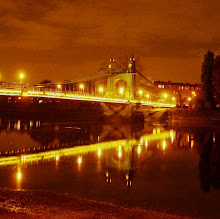I got up before 6 this morning to race in a four. We lost.
F*ck.
Nothing more to say there, then.
Finding myself at a loss at around 10 am on a Saturday being a rarity, I had a cup of tea with an equally angry and disappointed crewmate, then we took single sculls out onto the water.
I haven't been out in a single for nearly two years, and I wasn't expecting miracles. Singles are incredibly unstable, and my aim for the outing was to get away from the raft and back to it without capsizing. Any strokes I managed to take inbetween pushing off and landing counted as a bonus. The only river I've singled on previously is the Wey in Guildford, an 800m stretch with banks within touching distance at all points, no tides to contend with, and no cruisers creating monster-sized wash. I've also sculled on Edgbaston Reservoir, an overgrown muddy puddle in the middle of Birmingham. Conditions there tended to be flat, with the only real hazards being the occasional angler who would practice their aim by attempting to stone passing scullers, and the prevailing wind which would whip the water against the vertical wall at the far end of the reservoir, creating massive waves (massive when viewed from a scull).
I don't know the Thames well. True, I've rowed up and down it quite a bit now, and run along various bits of it, but for most of the time, I'm thinking about my stroke relative to the water, and not having to worry about things like what the stream is doing and whether the boat is correctly positioned in/out of it, or whether the boat is orientated to travel along the river or towards the bank. What with banks being irregularly shaped and rivers having bends, and scullers travelling in the opposite direction to that in which they are facing, getting a scull up and down a river without ending up heading either for the bank or for another boat is not as easy as it might at first seem.
Thankfully I wasn't going out alone, I would have a crewmate sculling nearby to keep me out of too much trouble and tell me where to cross the river. One thing she couldn't do for me, though, was to sit the boat.
Translation of boatie jargon for non-rowers: “Sitting the boat” means getting/keeping the boat balanced such that both right and left sides of the boat are level above the water. If this is not the case, the boat is described as being “down on bow/stroke side”, depending on which way it is tilting. In the picture below, the rower is looking away from you:

The only time I have capsized a scull was during a short outing at Guildford. My outing lasted approximately half a second - I pushed off with the bank on my stroke side, and immediately flipped the boat over my bowside. I landed in about four foot of water, and hauled myself onto the bank, very wet and rather angry with myself. I didn't fancy doing the same thing on the Thames, so I got a bit (read: lot) of help to get me out onto the water, where I discovered that singling really is like riding a bike – if you haven't done it for a while, it's best to avoid ever doing it again, or failing that to put stabilisers on.
My scull didn't come with the scull version of stabilisers. Just me and my sculls (sculling blades/oars), with my crewmate disappearing across the river. I was trying to remember how to avoid capsizing, whilst moving the scull backwards without capsizing, and making an attempt at steering also without capsizing.
Ten minutes after getting on the water, I'd managed to get about a hundred metres, crossing the stream from the incoming tide to the other side of the river. Without capsizing.
Incoming tide? We didn't have to deal with things like that in Guildford. Nor did we have to deal with the possibility of there being other crews on the water which didn't know that someone had gone out in a single for the first time in a while and therefore probably best to give them a wide berth.
But I hadn't capsized. So far, so good.
Just as I was remembering what sculling felt like, the next reminder that I wasn't in Guildford any more cropped up. This time, it was the wash from a coaching launch, which hurled me up and down for a while whilst pushing me rather closer towards the bank than I would have liked. The bank also looked rather less soft than the corresponding Guildford feature, being made of concrete rather than mud and tree roots and grass and things, which I imagine are rather more forgiving to crash into than concrete. I sat it out whilst pondering the thought that perhaps heading out in a single after a race without having had much sleep recently nor much food that morning may not have been the best plan I'd ever hatched.
Still, I hadn't capsized. I'd more or less managed to deal with one more unfamiliar Thames challenge, and I was remarkably dry. I'd even managed to take a few strokes in succession with the boat reasonably nicely sat, and picking up some speed. Enough to keep me within sight of my crewmate, just in case... I was just getting comfortable when Hammersmith Bridge loomed large. Fortunately, there was plenty width under the Surrey side of the central span for me to aim through.
A few hundred metres of uneventful sculling further on, the next challenge was spinning to head back. Whilst in Guildford I'd been pretty nifty with my spinning (through necessity – there wasn't much spare room to move the boat forwards or backwards without colliding with one bank or another), I now had maybe eighty metres of river in which to get my boat turned round. Granted, about thirty of those metres were a bit close to sewage outlets and therefore preferable not to get involved with, but I had more than ample space to turn round in. The problem was, I didn't really want ample space, I wanted to spin my scull on the spot, as I felt sure I'd capsize just pulling it round using only my bow side blade and end up in the sewage (another thing I didn't have to contend with in Guildford), probably catching yet another gastro unpleasantness.
But I didn't. I'd got halfway, spun, and still not capsized.
Halfway - I was reminded at this point that most fatalities in mountaineering happen after the summit has been reached. I didn't want the way back to prove my undoing, particularly as I felt I was beginning to rediscover some familiarity with the sculling movement and getting to be able to predict the movement of the boat in the water.
Heading back, we kept close to the middle of the river, making the most of the stream. Being in a small boat in the middle of a big river was less unnerving than I had anticipated. The bigger problem was getting away from my attachment to planning my course based on the curves of the bank, and instead looking much further down the river, pointing more or less down the centre.
Back under Hammersmith bridge and having avoided moored boats (without capsizing), the sight of several hundred sailing boats (well, at least ten...) moving apparently at random was not welcome. I figured I'd sit in plenty of space and wait for my crewmate to do something sensible, and attempt to copy it. Five minutes later, I'd rowed past the club raft, spun, paddled back and drawn my scull up to the raft, been pulled in, was back on a solid surface, and all without capsizing. Success...
I went out in a single on the Thames and didn't capsize. It almost, almost, made up for losing.
--
Photo credits:
Top from Nicholos Masse's flickr photostream.
Bottom from Tony Spencer's flickr photostream.



![[Mother+of+Shrek+winner!.jpg]](http://bp0.blogger.com/_wmVJl3A0om8/R2DjlQJtYfI/AAAAAAAAAzQ/sDljl7IClfw/s1600/Mother%2Bof%2BShrek%2Bwinner!.jpg)


11 comments:
Wow. In spite of the suspense in reading your story I'm glad it ended well.
Also, fyi I tagged you for a meme.
Me too - the river was looking awfully murky after rain in the previous week. I wouldn't have fancied being pitched into something so unhealthy-looking. A day later, I'm still chuffed about it.
Meme duly noted - thanks. I'll post it in coming week.
This post held me captive till the last word! I know you don't believe me but really, you are such a brilliant writer. STOP, don't argue...you write very well! The photos were gorgeous too, are the phtographers professionals?
DJ,
Seeing as you're my guest here, I shall agree with you wholeheartedly. (I may have to have my fingers crossed the whole time, but they will be behind my back and you'll not see a thing!)
Erm, I have no idea whether the guys who took the pictures are pros or not - they'd both made their stuff available under creative commons, so I'm guessing not (that or fre market economics is missing something somewhere). I love both those pictures - they capture something of the zen.
Yep, riveting! I had no idea sitting in a single would be such hard work, but I have various parts clenched just to help you along!
Rob,
I think it's perhaps easier to appreciate if I'd mentioned that rather than sitting in the boat, one more or less sits on the boat. For the truely interested with too much time to spare, there is an informative analysis here. It's best suited to rowing geeks with an appreciation of fluid mechanics.
Thanks for the clenches - if you could manage to maintain that each Saturday and Sunday between 8am and 12:30pm to help my balance along, that'd be just grand!
Drat. *hug*
Andy,
Yup. Losing really, really sucks.
What a comprehensive post. I love the photographs. I'm mightly impressed that anyone dares venture in the Thames at all. My only experience of things aquatic is singing a campfire song about barges "Port shines greeen and starboard's glowing red" or maybe vice-versa? But I guess you don't have lights on a scull - or indicators, come to that. Maybe a rear--view mirror would come in handy. Or GPS.... but then I suppose you would be perilously close to motor-cruiser territory.
They do have some rather fine rowing boats called 'gigs' down in my sister's neck of the woods, which seem to be crewed by rather Amazonian descendants of Grace Darling.
Shame you lost, though. At least it's Jolly Boating Weather now, or do the perils increase as the day-trippers crawl out of the wood-work?
I love your diagram of the boat balance! Will put it into my blog too.
Rebecca Caroe
Prof. Northerner,
I try my very best not to venture into the Thames - and as of this evening, I'm still succeeding. I did have the shortest outing in history this evening whn I got pushed off the pontoon and swept around the other side, at which point I got one of my sculls (blades/oars/sticks) stuck under the pontoon. Not a good position to be in, and not one that features prominently in any manuals of sculling best practice. So I ended up performing an experiment in whether it was possible to land on the wrong (high) side of the pontoon (ably assisted by a couple of the men). And it is. The whole outing lasted less than a minute. I'm rather hoping I get some sort of award for this - I consider it my insurance against not winning anything all season...
Rebecca,
Thanks, and you're most welcome - I'll probably upversion it to add in some riggers - it looks a bit precarious as it is. Help yourself to either/both.
Post a Comment